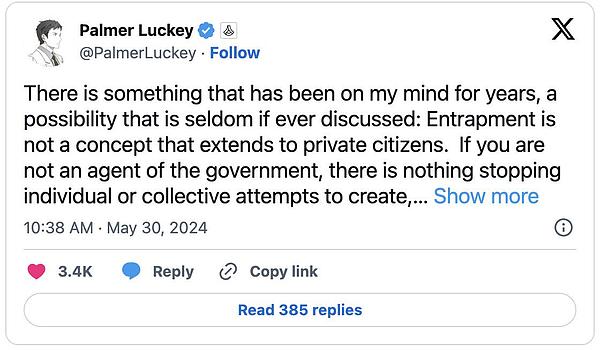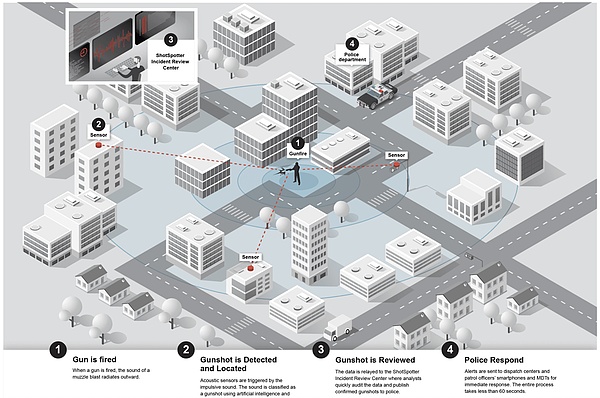Written by Luffistotle, Zee Prime Capital; Translated by Tia, Techub News
Recently, the problem of security order in the West has begun to emerge. Usually, the way we use to measure whether the order is good is to walk in cities and parks during the day and at night (to see if it is safe). But now this measurement method is becoming less and less reliable. Social order is constructed and maintained by three components:
Laws and social norms
Law enforcement (police, surveillance, etc.)
Justice (application of law)
The interaction between these three is complex and deeply integrated. When people begin to be afraid to walk in the park, or when stores begin to move their positions and not operate in the original city (usually a very obvious sign), it indicates that there is a problem with governance. In fact, some of the current policies do have some problems. In fact, we can try to understand the possibility of crypto improving law enforcement, which will help improve social structure. We will discuss this below, focusing on the application of crypto in surveillance tools.
Looking back at history, in periods of declining trust in public institutions and protocols (laws), societies often resort to lynching to solve their problems. This power was originally used to solve practical problems in the community, but it eventually became corrupt and evolved into extortion.

Perhaps there are more modern solutions now, such as cheaper surveillance technology, through which law enforcement agencies may be given "leverage" to solve problems at scale to ensure that the goals and aspirations of the community are achieved. Technology can enable the same number of people to do more. And decentralized protocols can help ensure that this new power is not used for other purposes.
The idea of strengthening law enforcement through surveillance is actually terrifying because there is a threat of abuse of power.
"Absolute power leads to absolute corruption."
Cryptocurrency brings the possibility of financial freedom - it eliminates the state's monopoly on currency and checks and balances the state's financial behavior. Likewise, it can act as a check on new surveillance tools. By combining ubiquitous, cheap robots, cameras, and sensors with a reliable, neutral collaborative network, the state’s surveillance monopoly can be checked.
In the category of projects we call DeSec, we explore this in depth through interesting conversations with great people. The security space is another opportunity for crypto because it is one of the few areas where customers (governments, communities) are willing to pay for insurance (defense is happy to pay for redundancy). Redundancy costs are an inherent feature of crypto. This feature is also the reason why many crypto products are generally unable to compete with other solutions, crypto needs to constantly pay for higher levels of security/redundancy/validation.
That being said, redundancy is not a bad thing. It is a trade-off between deterministic fixed costs and variable future costs. In the case of Bitcoin, its value and success is derived from the fees paid to achieve trustless validation (breaking consensus is expensive, so its security is extremely high). In defense manufacturing, the tolerance rate or failure rate for security is also extremely low, even if it costs a lot to do so.
DePIN meets DeSec: NeighborhoodWatchDAO
Much of DePIN’s value comes from shifting the burden of capex from the company/protocol to the node runners in exchange for a percentage of revenue. This opens up the possibility for many types of networks to scale in ways that would not otherwise be possible.
With these features, there are some immediate applications that can be brought to market. As an example, Dempsey is a DePIN-style network of SoundThinking (formerly ShotSpotter) nodes that can either sell to ShotSpotter itself or have its own protocol. For those unfamiliar, ShotSpotter is a network of microphones mounted on buildings that triangulate the location of a shooting and alert law enforcement or first responders so resources can be deployed faster/immediately.

Such protocols could scale globally as node operators deploy to their respective cities, much faster than the internal reinvestment cycles of companies like SoundThinking.
Similarly, there is a growing risk of small drones intruding into potentially important airspace. As the recent intrusion at Langley Air Force Base showed us. While the US military may have a classified solution to such attacks, another solution may be needed for other less secure airspace. This could be achieved by incentivizing a small radar or visual observation network in the relevant airspace to help law enforcement understand the relevant situation of the emission point.
Similar models can also be used to observe signal strength. (While this is usually provided by wireless providers to ensure network quality, wireless providers also have shortcomings and their signals are often more transient.) DePIN can provide continuous signal quality monitoring for these networks (as some projects such as ROAM already plan to do). This is a simpler implementation solution.
In recent years, there has been a surge in the number of cheap cell phone jammers in the hands of thieves. These devices are scary because you might find that when someone breaks into your house, your phone, wifi, or radio can't contact the police.
Criminals can put it in their belts and then rob your house or steal your car. Signal monitoring in cities and other areas can easily detect these jammers. Similar to ShotSpotter, authorities can also be alerted.
We can also create similar protocols to regularly incentivize small drones that conduct surveillance in problem areas (Patrol2earn), or we can leverage existing DePIN projects to support surveillance agencies. Projects such as Frodobots or DIMO capture key events with cameras.
Communications
Similar to the surveillance part, DePIN networks can also be used to enhance the robustness of network transmissions, whether electrical or digital. The benefit is that such networks can remain stable even in the event of a disaster.
Meshed edge networks can protect against today’s highly centralized CDN-centric internet traffic, while decentralized power plants can coordinate small-scale energy production to provide backup power when major production centers are targeted.
This logic also applies to modern warfare. In fact, modern frontline forces need to be more decentralized. The use of FPV drones, as we have seen in Ukraine, is a major development in warfare. Small, low-cost (even cardboard drones), and fast precision strikes are now possible. Any critical facilities on the battlefield (i.e. logistics hubs, transmission/command bunkers, etc.) will become targets. This will cause these small facilities to become points of failure, and the best way to deal with them is to use distributed communications.
Do you still want to use missiles in this economic situation?
Authentication
Multi-party authentication can be applied to robotic manufacturing. Entering malicious instructions into a manufacturing robot can pose a serious risk to the entire manufacturing chain. One way to solve this type of problem can be to multi-party authenticate the code while it is running. By reaching a consensus on the code to be executed, malicious changes to the manufacturing process can be caught.
Similar to Verification, STAEX provides a public network to facilitate trustless communication between IoT devices. This provides a novel way for these devices to communicate and reduces the risk of interference using traditional channels. Given the increasing risk of wrongdoing, this is an important technology to build a strong network that allows these devices to transmit valuable data.
Other uses of Verification include citizen submission of evidence (snitch2earn) as mentioned above by Palmer Luckey. Highly complex operations such as covert identities and decoy vehicles may be difficult to perform within the current legal framework, but despite this, there are still a lot of ways to record criminal behavior in this day and age, set up a simple venue to deploy data, and even contextualize location/time verification through cryptography (ZK!!!).
DeSci
DeSci is another way that cryptography is merging with the defense/intelligence industry. For example, DeSci DAOs fund research in otherwise underappreciated areas like materials science, biofabrication (like valleyDAO), cryogenics (CryoDAO), or longevity (Vita)/human performance enhancement (anyone want to join me on a peptide DAO?). These DAOs can actually have a meaningful impact on these research areas. For example, HairDAO is now one of the largest non-hair loss research funders in the world.
I believe that more cutting-edge research innovation will come from this type of DAO as more scientists are abandoning traditional research paths.
Why Protocols Matter
Why do we need protocols? Many of the ideas presented above are clearly about enhancing state-ruled surveillance. However, suppose these surveillance tools were brought to market and governed by protocols. In this case, decentralized governance could check whether the authorities using them are enforcing the law properly, and whether the values of those governing the monopoly are aligned with those of the people they govern? If not, the protocol could vote to no longer provide value-added information to law enforcement agencies (perhaps they would choose to support private police forces or private intelligence agencies).
Skeptical Comments
Increasing surveillance capabilities are likely to have negative effects on society, regardless of who controls them. Don’t overly question the practical possibility of decentralized governance, because similar to Bitcoin, such protocols must rely on absolute permissionlessness, i.e. governance minimization. i.e. maximum trustlessness.
Society is constantly evolving, and the ability to enforce absolute rule of law may undermine our ability to adapt. Disobedience can promote progress, albeit a very specific form of disobedience (not street crime). How can specific types of crime be eliminated? This can become a slippery slope if surveillance technology is maximized.
Therefore, we must be careful to protect privacy when implementing technologies that help maintain the established order. We humans must have the ability to speak outrageous thoughts and resist tyranny. If the asymmetry between enforcement and resistance becomes too great, we are simply promoting Minority Report-style tyranny.
If we look deeper into this asymmetry, we see that the right to bear arms in the United States is already meaningless; when it was established, its goal was to ensure the possibility of potential resistance, but once we invented missiles (not to mention nuclear weapons), this possibility no longer exists. Of course, the right of individuals to defend their property still exists, but it is ineffective in terms of government resistance.
Crypto has the unique ability to take the market into a new realm. Will the future be MerceneryDAOs, crypto-funded defense technology, community-owned drones, or libertarian pacifism? No one knows. Maybe the answer lies in more niche areas, such as decentralized micro-nuclear plant monitors and drone protection networks, or maybe the answer lies in places we haven't even considered.
 Catherine
Catherine





